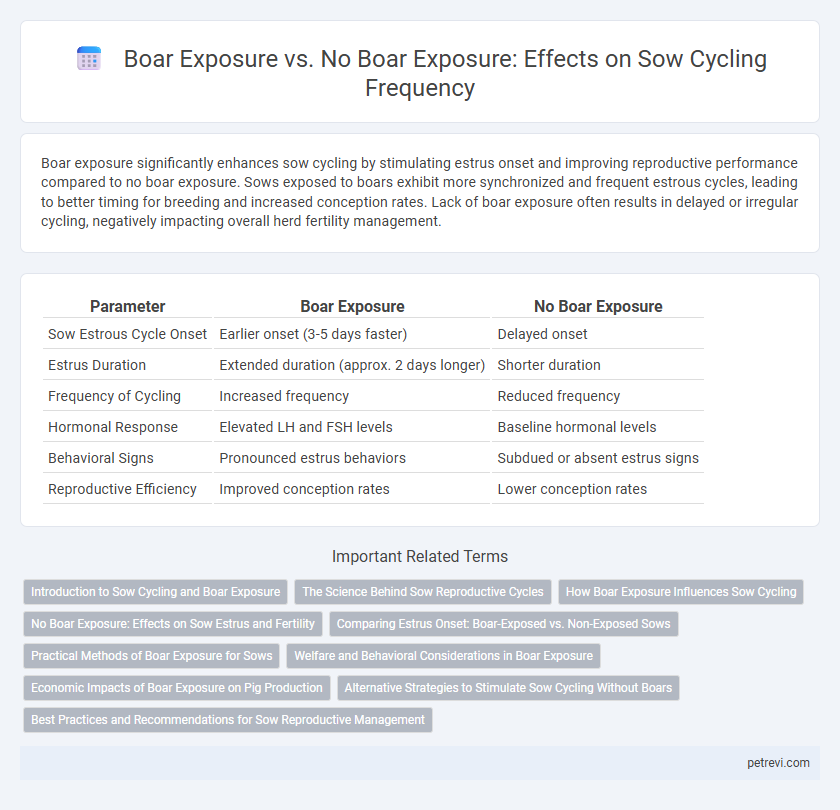Boar exposure significantly enhances sow cycling by stimulating estrus onset and improving reproductive performance compared to no boar exposure. Sows exposed to boars exhibit more synchronized and frequent estrous cycles, leading to better timing for breeding and increased conception rates. Lack of boar exposure often results in delayed or irregular cycling, negatively impacting overall herd fertility management.
Table of Comparison
| Parameter | Boar Exposure | No Boar Exposure |
|---|---|---|
| Sow Estrous Cycle Onset | Earlier onset (3-5 days faster) | Delayed onset |
| Estrus Duration | Extended duration (approx. 2 days longer) | Shorter duration |
| Frequency of Cycling | Increased frequency | Reduced frequency |
| Hormonal Response | Elevated LH and FSH levels | Baseline hormonal levels |
| Behavioral Signs | Pronounced estrus behaviors | Subdued or absent estrus signs |
| Reproductive Efficiency | Improved conception rates | Lower conception rates |
Introduction to Sow Cycling and Boar Exposure
Sow cycling is a crucial reproductive process influenced significantly by boar exposure, which triggers estrus through pheromonal cues and physical presence. Boars emit specific pheromones that stimulate hormonal changes in sows, promoting regular and earlier onset of cycling compared to sows without boar exposure. Studies show sows exposed to boars exhibit improved estrus detection rates, enhancing breeding efficiency and overall reproductive success in swine production.
The Science Behind Sow Reproductive Cycles
Boar exposure significantly influences sow reproductive cycles by stimulating the release of pheromones that trigger hormonal responses essential for estrus onset. Studies show that sows exposed to boars exhibit earlier and more consistent estrus compared to those without boar contact, highlighting the role of sensory cues in regulating reproductive hormones like luteinizing hormone and follicle-stimulating hormone. This biological mechanism underscores the importance of controlled boar exposure in optimizing breeding programs and enhancing sow fertility outcomes.
How Boar Exposure Influences Sow Cycling
Boar exposure significantly accelerates the onset of estrus in sows by stimulating the release of pheromones that trigger hormonal changes essential for cycling. Sows with regular boar contact exhibit shorter weaning-to-estrus intervals and more synchronized ovulation compared to those without exposure. This natural stimulation improves reproductive efficiency and enhances overall herd fertility.
No Boar Exposure: Effects on Sow Estrus and Fertility
No boar exposure significantly delays the onset of estrus in sows, leading to extended weaning-to-estrus intervals and irregular estrous cycles. This absence of boar stimuli reduces the efficiency of reproductive hormone secretion, resulting in lower estrus detection rates and decreased conception rates. Consequently, sows without boar exposure exhibit compromised fertility performance, affecting overall herd productivity and breeding success.
Comparing Estrus Onset: Boar-Exposed vs. Non-Exposed Sows
Boar exposure significantly accelerates estrus onset in sows, with exposed sows typically exhibiting signs of estrus 4 to 7 days earlier than non-exposed counterparts. Research indicates that pheromones and tactile stimulation from boars trigger hormonal responses, enhancing follicular development and shortening the weaning-to-estrus interval. In contrast, non-exposed sows often experience delayed or inconsistent estrus onset, negatively impacting reproductive scheduling and efficiency in swine production.
Practical Methods of Boar Exposure for Sows
Boar exposure significantly accelerates sow estrous cycling by stimulating olfactory and tactile senses through direct contact or fence-line exposure. Practical methods include controlled fence-line contact, boar pens adjacent to sow stalls, and tactile stimulation such as rubbing or allowing sows to sniff boar hair. These techniques enhance reproductive efficiency by triggering hormonal responses that promote timely and synchronized estrus onset.
Welfare and Behavioral Considerations in Boar Exposure
Boar exposure significantly influences sow cycling by enhancing estrus expression and reducing weaning-to-estrus intervals, which promotes natural reproductive behavior and supports sow welfare. Observing boars triggers behavioral responses such as increased activity and vocalization, reflecting positive stimulation and reduced stress levels compared to no boar exposure scenarios. Lack of boar contact can lead to subdued estrus signs and potential behavioral issues, highlighting the importance of boar exposure for improving sow well-being and reproductive efficiency.
Economic Impacts of Boar Exposure on Pig Production
Boar exposure significantly reduces the interval between weaning and estrus in sows, accelerating the breeding cycle and improving herd productivity. This enhanced reproductive efficiency leads to increased piglet output per sow annually, thereby boosting overall farm profitability. Reduced non-productive days due to timely cycling also lower feed and labor costs, optimizing economic returns in pig production systems.
Alternative Strategies to Stimulate Sow Cycling Without Boars
Alternative strategies to stimulate sow cycling without boar exposure include the use of hormonal treatments such as GnRH analogs and prostaglandins to regulate estrus cycles effectively. Environmental enrichment and controlled lighting programs can also enhance reproductive behaviors and promote timely cycling in sows. Nutritional adjustments, particularly increasing energy intake and amino acid balance, support ovarian activity and improve estrus expression in the absence of boar stimuli.
Best Practices and Recommendations for Sow Reproductive Management
Boar exposure significantly enhances the onset and regularity of estrous cycles in sows, promoting optimal reproductive performance. Best practices recommend daily direct contact or fence-line exposure to mature, sexually active boars starting five to seven days post-weaning to stimulate timely return to estrus. Reproductive management protocols integrating consistent boar exposure improve conception rates, reduce weaning-to-estrus intervals, and support efficient sow productivity.
Boar exposure vs No boar exposure for Sow cycling Infographic

 petrevi.com
petrevi.com